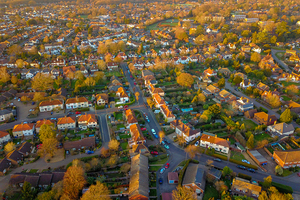 Research led by Bartlett School of Planning (UCL) academics, published by the Ministry of Housing, Communities and Local Government (MHCLG), concludes that new housing created through permitted development rights in England since 2013 is more likely to be characterised by ‘worse’ quality residential environments than housing created under the full planning permission process in relation to a number of factors vital to the health, wellbeing and quality of life of future occupiers.
Research led by Bartlett School of Planning (UCL) academics, published by the Ministry of Housing, Communities and Local Government (MHCLG), concludes that new housing created through permitted development rights in England since 2013 is more likely to be characterised by ‘worse’ quality residential environments than housing created under the full planning permission process in relation to a number of factors vital to the health, wellbeing and quality of life of future occupiers.
image: for illustration purposes only – Open Government Licence v3.0
UCL writes:
The report, Research into the quality standard of homes delivered through change of use permitted development rights, was commissioned by the Ministry….
The research compared the quality of new housing created between 2015 and 2018 through the change of use of buildings formerly in office, storage, light industrial, retail and various associated commercial uses into residential use through the deregulated ‘permitted development’ route with the quality of housing created through the more detailed planning permission process. This involved site visits to 639 buildings and detailed desk based analysis of 240 schemes (creating 3,156 new housing units) across eleven case study local authorities (Bristol, Crawley, Derby, Enfield, Huntingdonshire, Manchester, Richmond, Sandwell, Sunderland, Wakefield and Waverley).
The evidence in the study shows a slightly more nuanced picture than has sometimes been suggested in relation to the quality created through the two consenting routes, with overall similar rates of making exterior alterations (such as new doors, windows or cladding), similar energy performance ratings and similar levels of access to neighbourhood services between permitted development and planning permission schemes.
There were, however, significant differences in relation to space standards, with just 22.1% of permitted development dwellings meeting the Nationally Described Space Standards, compared to 73.4% of planning permission homes (and the permitted development units often being considerably below the suggested standards). There were also worse arrangements of windows under permitted development (with 72% of the permitted development dwellings only having single aspect windows, compared to 29.% of the planning permission dwellings). Examples of housing units with no windows at all created under permitted development were found, as well as schemes with contrived layouts whereby there would little natural light to the majority of the unit.
Regarding amenity space, just 3.5% of permitted development dwellings had access to private amenity space (such as a balcony, garden or roof terrace) compared to 23.1% of the planning permission ones. Permitted development schemes were also more likely to be situated in primarily commercial areas, like business parks and industrial estates, than planning permission schemes (7.9% of all permitted development schemes were in such locations, compared to 1.0% of planning permission schemes).
Dr Ben Clifford commented, “There has been some controversy surrounding these permitted development rights because of concerns over the quality of housing that can be created through them…..

